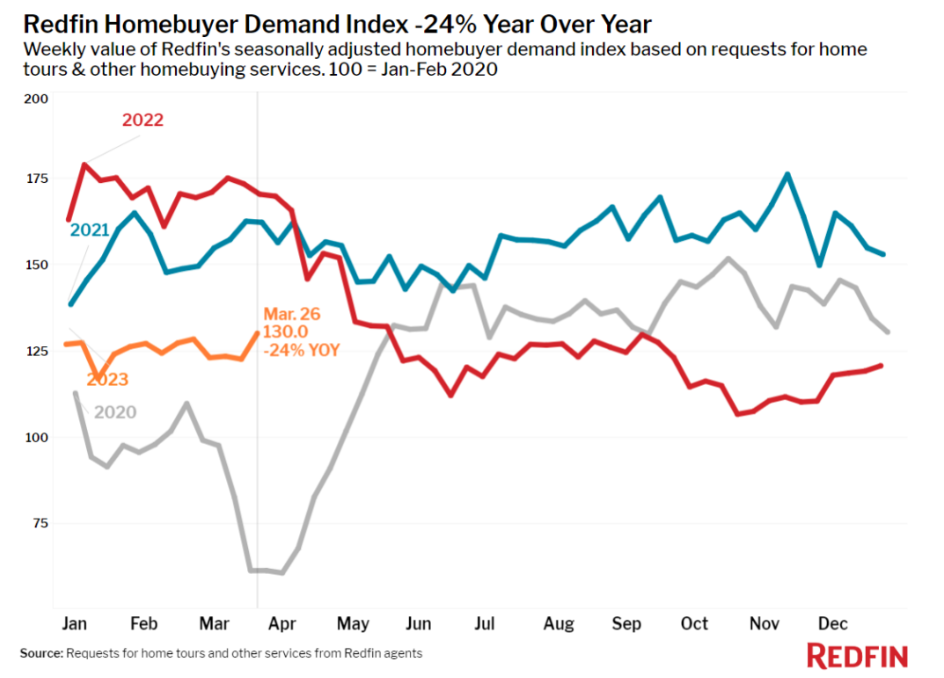 Mortgage-rate locks for second homes and investment properties were down 52% from pre-pandemic levels on a seasonally adjusted basis in March, according to a new report from Redfin–compared to a 13% decline for primary homes. Second-home rate locks fell to their lowest level since 2016 in February and remained nearly as low in March.
Mortgage-rate locks for second homes and investment properties were down 52% from pre-pandemic levels on a seasonally adjusted basis in March, according to a new report from Redfin–compared to a 13% decline for primary homes. Second-home rate locks fell to their lowest level since 2016 in February and remained nearly as low in March.
The drop in second-home demand follows a rise during the pandemic homebuying boom. Mortgage-rate locks for second homes reached a peak of 89% above pre-pandemic levels in August of 2020, a time when many affluent Americans bought homes in vacation destinations, encouraged by low mortgage rates, and remote work opportunities.
Short supply, mortgage rates exceeding the 6% mark, still-high home prices, and persistent inflation, have been cited as reasons holding back demand for both primary and second homes.
As a result of these factors, many potential second-home buyers have been priced out because it’s frequently more expensive to buy a vacation home than a primary home. The value of a typical second home stood at approximately $465,000 in 2022, versus $375,000 for a primary home. Additionally, the federal government increased loan fees for second homes in April 2022.
“With housing payments near their all-time high; a lot of people can’t afford to buy one home right now, let alone a second,” said Redfin Deputy Chief Economist Taylor Marr. “Add the recent increase in loan fees, inflation, shaky financial markets, the end of pandemic-related financial stimulus and many companies calling workers back to the office, and it’s simply a challenging time for most Americans to buy a vacation home.”
Redfin recently found that the pool of homes available to homebuyers is shrinking quickly because new listings are scarce. New listings fell 21.8% from a year earlier nationwide during the four weeks ending April 2, one of the biggest drops since the start of the pandemic, contributing to an unseasonal early-spring decline in the total number of homes for sale.
Vacation-home buyers were quicker to pull back from the market than primary-homebuyers because second homes are not deemed a necessity.

Another factor dampening that demand for vacation homes is that workers are returning to the office, making second homes less attractive when there’s less time to spend in them. While working from home is more common than it was before the pandemic, the share of job openings that allow remote work has shrunk since early 2022.
Buying a vacation home to rent it out is nowhere near as attractive as it was during the pandemic homebuying and investing boom. Owners of short-term rentals are reporting a steep decline in business. That’s because many people became vacation-rental hosts during the pandemic, which led to oversupply. Many local governments are also instituting new short-term-rental regulations, like new taxes and stricter permitting.
Despite the falloff in vacation home interest, Phoenix Redfin Agent Van Welborn said some buyers are looking for vacation condos, especially in desirable neighborhoods.
“It’s mostly affluent cash buyers who don’t have to worry about high rates,” Welborn said. “They’re motivated to buy now because they think they can get a vacation home for under asking price–and in some cases, they’re right. There are fewer buyers looking to buy properties to be used as short-term rentals, though, as they’re finding that the market is saturated.”

 DSNews The homepage of the servicing industry
DSNews The homepage of the servicing industry









